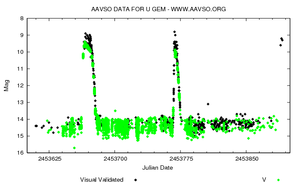U Geminorum
 AAVSO light curve of U Geminorum's outburst behavior. Different colors reflect different bandpasses. Day numbers are Julian day. |
|
| Observation data Epoch J2000.0 Equinox J2000.0 |
|
|---|---|
| Constellation | Gemini |
| Right ascension | 07h 55m 05.24s |
| Declination | +22° 00′ 05.1″ |
| Apparent magnitude (V) | 14.1-15.0 (quiet), 9.0 (outburst) |
| Characteristics | |
| Spectral type | sd:Be+ / M4.5Ve |
| Variable type | Dwarf nova |
| Astrometry | |
| Radial velocity (Rv) | +42.0 km/s |
| Proper motion (μ) |
RA: -30.0 mas/yr Dec.: -42.2 mas/yr |
| Parallax (π) | 7.9 ± 5.4mas |
| Distance | approx. 400 ly (approx. 130 pc) |
| Absolute magnitude (MV) | 9.5 |
| Orbit | |
| Primary | Red dwarf |
| Companion | White dwarf |
| Period (P) | 0.1769062 days |
| Semi-major axis (a) | 1.55±0.02 R☉ |
| Eccentricity (e) | 0.027 |
| Inclination (i) | 69.7±0.7° |
| Details | |
| White dwarf | |
| Mass | 1.2±0.05 M☉ |
| Red dwarf | |
| Mass | 0.42±0.04 M☉ |
| Radius | 0.43±0.06 R☉ |
| Other designations | |
|
U Gem, BD+22 1807, HD 64511.
|
|
U Geminorum (U Gem), in the constellation Gemini, is an archetypal example of a dwarf nova. The binary star system consists of a white dwarf closely orbiting a red dwarf. Roughly every 100 days it undergoes an outburst that greatly increases its brightness. It was discovered by J.R. Hind in 1855 who initially thought it was a nova; it quickly faded below his telescope's limiting magnitude. Its true nature was revealed three months later when it was reobserved in outburst by Pogson. The star has been monitored by amateur and professional astronomers ever since, though its location near the zodiac means that some outbursts are undoubtedly missed due to the seasonal gap.
The U Geminorum binary has a very short orbital period of 4 hours and 11 minutes; this orbit alone makes the system variable, as the components transit and eclipse each other with each revolution. Normally, the combined apparent magnitude varies between 14.0 and 15.1; during an outburst however, the star can brighten a hundredfold, to 9th magnitude. Though the average interval is 100 days, the period is in fact highly irregular, varying from as little as 62 days to as long as 257. As is the case with dwarf novae, the outbursts are theorized results of a periodic surge of influx from the white dwarf's accretion disk, caused by instability in the disk itself.
Distance estimates for U Geminorum have varied from 52 parsecs (170 light-years) to 112 parsecs (370 light-years), with a best estimate of 82 parsecs (270 light-years).
...
Wikipedia
